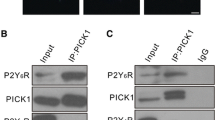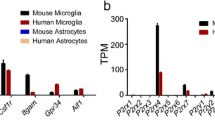Abstract
The movement of microglia is regulated mainly by P1 and P2 purinergic receptors, which are activated by various nucleotides and their metabolites. Recently, such purinergic signalling has been spotlighted because of potential roles in the pathophysiologies of neurodegenerative and neuropsychiatric disorders. To understand the characteristics of microglia in relation of P1 and P2 signalling, we investigated the ectoenzymes expressed in microglia. At first, we profiled the expression of all known ectoenzymes in cultured microglia. We found that, like NTPDase1 (ectonucleoside triphosphate diphosphohydrolase 1, CD39), NPP1 (ectonucleotide pyrophosphatase/phosphodiesterase 1, PC-1) is also highly expressed in primary cultured murine microglia. Knockdown of NPP1 significantly reduced ATP hydrolysis and Pi production in cultured microglia. In addition, the knockdown of NPP1 enhanced basal nucleotide-stimulating responses of cultured microglia, such as phagocytosis and cell migration, and these results were very similar to NTPDase1 knockdown results. Moreover, inhibition of the adenosine receptors by caffeine treatment reduced phagocytosis of NPP1 knock downed-cultured microglia. In conclusion, we suggest that these potent ectoenzymes of primary cultured murine microglia, NPP1 together with CD73 (ecto-5′-nucleotidase) maintain the adenosine levels for triggering nucleotide-stimulating responses.





Similar content being viewed by others
Abbreviations
- CNS:
-
Central nerve system
- NPP:
-
Ectonucleotide pyrophosphatase/phosphodiesterase
- GFAP:
-
Glial fibrillary acidic protein
- LPS:
-
Lipopolysaccharides
- MAP2:
-
Microtubule-associated protein 2
- NTPDase:
-
Ectonucleoside triphosphate diphosphohydrolase
- UDP:
-
Uridine 5′-diphosphate
References
Burnstock G (2012) Purinergic signalling: its unpopular beginning, its acceptance and its exciting future. BioEssays 34(3):218–225. https://doi.org/10.1002/bies.201100130
Abbracchio MP, Burnstock G, Verkhratsky A, Zimmermann H (2009) Purinergic signalling in the nervous system: an overview. Trends Neurosci 32(1):19–29. https://doi.org/10.1016/j.tins.2008.10.001
Czirr E, Wyss-Coray T (2012) The immunology of neurodegeneration. J Clin Invest 122(4):1156–1163. https://doi.org/10.1172/jci58656
Block ML, Zecca L, Hong JS (2007) Microglia-mediated neurotoxicity: uncovering the molecular mechanisms. Nat Rev Neurosci 8(1):57–69. https://doi.org/10.1038/nrn2038
Robson SC, Sevigny J, Zimmermann H (2006) The E-NTPDase family of ectonucleotidases: structure function relationships and pathophysiological significance. Purinergic Signal 2(2):409–430. https://doi.org/10.1007/s11302-006-9003-5
Zimmermann H, Zebisch M, Strater N (2012) Cellular function and molecular structure of ecto-nucleotidases. Purinergic Signal 8(3):437–502. https://doi.org/10.1007/s11302-012-9309-4
Joseph SM, Pifer MA, Przybylski RJ, Dubyak GR (2004) Methylene ATP analogs as modulators of extracellular ATP metabolism and accumulation. Br J Pharmacol 142(6):1002–1014. https://doi.org/10.1038/sj.bjp.0705865
Stefan C, Jansen S, Bollen M (2006) Modulation of purinergic signaling by NPP-type ectophosphodiesterases. Purinergic Signal 2(2):361–370. https://doi.org/10.1007/s11302-005-5303-4
Braun N, Sevigny J, Robson SC, Enjyoji K, Guckelberger O, Hammer K, Di Virgilio F, Zimmermann H (2000) Assignment of ecto-nucleoside triphosphate diphosphohydrolase-1/cd39 expression to microglia and vasculature of the brain. Eur J Neurosci 12(12):4357–4366
Bulavina L, Szulzewsky F, Rocha A, Krabbe G, Robson SC, Matyash V, Kettenmann H (2013) NTPDase1 activity attenuates microglial phagocytosis. Purinergic Signal 9(2):199–205. https://doi.org/10.1007/s11302-012-9339-y
Kato K, Nishimasu H, Okudaira S, Mihara E, Ishitani R, Takagi J, Aoki J, Nureki O (2012) Crystal structure of Enpp1, an extracellular glycoprotein involved in bone mineralization and insulin signaling. Proc Natl Acad Sci U S A 109(42):16876–16881. https://doi.org/10.1073/pnas.1208017109
Nam HK, Liu J, Li Y, Kragor A, Hatch NE (2011) Ectonucleotide pyrophosphatase/phosphodiesterase-1 (ENPP1) protein regulates osteoblast differentiation. J Biol Chem 286(45):39059–39071. https://doi.org/10.1074/jbc.M111.221689
Okawa A, Nakamura I, Goto S, Moriya H, Nakamura Y, Ikegawa S (1998) Mutation in Npps in a mouse model of ossification of the posterior longitudinal ligament of the spine. Nat Genet 19(3):271–273. https://doi.org/10.1038/956
Zhang Y, Chen K, Sloan SA, Bennett ML, Scholze AR, O'Keeffe S, Phatnani HP, Guarnieri P, Caneda C, Ruderisch N, Deng S, Liddelow SA, Zhang C, Daneman R, Maniatis T, Barres BA, Wu JQ (2014) An RNA-sequencing transcriptome and splicing database of glia, neurons, and vascular cells of the cerebral cortex. J Neurosci 34(36):11929–11947. https://doi.org/10.1523/jneurosci.1860-14.2014
Ransohoff RM, Cardona AE (2010) The myeloid cells of the central nervous system parenchyma. Nature 468(7321):253–262. https://doi.org/10.1038/nature09615
Prinz M, Priller J (2014) Microglia and brain macrophages in the molecular age: from origin to neuropsychiatric disease. Nat Rev Neurosci 15(5):300–312. https://doi.org/10.1038/nrn3722
Kettenmann H, Hanisch UK, Noda M, Verkhratsky A (2011) Physiology of microglia. Physiol Rev 91(2):461–553. https://doi.org/10.1152/physrev.00011.2010
Salter MW, Beggs S (2014) Sublime microglia: expanding roles for the guardians of the CNS. Cell 158(1):15–24. https://doi.org/10.1016/j.cell.2014.06.008
Neher JJ, Neniskyte U, Zhao JW, Bal-Price A, Tolkovsky AM, Brown GC (2011) Inhibition of microglial phagocytosis is sufficient to prevent inflammatory neuronal death. J Immunol 186(8):4973–4983. https://doi.org/10.4049/jimmunol.1003600
Paolicelli RC, Bolasco G, Pagani F, Maggi L, Scianni M, Panzanelli P, Giustetto M, Ferreira TA, Guiducci E, Dumas L, Ragozzino D, Gross CT (2011) Synaptic pruning by microglia is necessary for normal brain development. Science 333(6048):1456–1458. https://doi.org/10.1126/science.1202529
Inoue K (2006) The function of microglia through purinergic receptors: neuropathic pain and cytokine release. Pharmacol Ther 109(1–2):210–226. https://doi.org/10.1016/j.pharmthera.2005.07.001
Domercq M, Vazquez-Villoldo N, Matute C (2013) Neurotransmitter signaling in the pathophysiology of microglia. Front Cell Neurosci 7:49. https://doi.org/10.3389/fncel.2013.00049
Koizumi S, Shigemoto-Mogami Y, Nasu-Tada K, Shinozaki Y, Ohsawa K, Tsuda M, Joshi BV, Jacobson KA, Kohsaka S, Inoue K (2007) UDP acting at P2Y6 receptors is a mediator of microglial phagocytosis. Nature 446(7139):1091–1095. https://doi.org/10.1038/nature05704
Ohsawa K, Irino Y, Nakamura Y, Akazawa C, Inoue K, Kohsaka S (2007) Involvement of P2X4 and P2Y12 receptors in ATP-induced microglial chemotaxis. Glia 55(6):604–616. https://doi.org/10.1002/glia.20489
Luongo L, Guida F, Imperatore R, Napolitano F, Gatta L, Cristino L, Giordano C, Siniscalco D, Di Marzo V, Bellini G, Petrelli R, Cappellacci L, Usiello A, de Novellis V, Rossi F, Maione S (2014) The A1 adenosine receptor as a new player in microglia physiology. Glia 62(1):122–132. https://doi.org/10.1002/glia.22592
Farber K, Markworth S, Pannasch U, Nolte C, Prinz V, Kronenberg G, Gertz K, Endres M, Bechmann I, Enjyoji K, Robson SC, Kettenmann H (2008) The ectonucleotidase cd39/ENTPDase1 modulates purinergic-mediated microglial migration. Glia 56(3):331–341. https://doi.org/10.1002/glia.20606
Heo DK, Lim HM, Nam JH, Lee MG, Kim JY (2015) Regulation of phagocytosis and cytokine secretion by store-operated calcium entry in primary isolated murine microglia. Cell Signal 27(1):177–186. https://doi.org/10.1016/j.cellsig.2014.11.003
Saura J, Tusell JM, Serratosa J (2003) High-yield isolation of murine microglia by mild trypsinization. Glia 44(3):183–189. https://doi.org/10.1002/glia.10274
Tamashiro TT, Dalgard CL, Byrnes KR (2012) Primary microglia isolation from mixed glial cell cultures of neonatal rat brain tissue. J Vis Exp: JoVE 66:e3814. https://doi.org/10.3791/3814
de Jong EK, de Haas AH, Brouwer N, van Weering HR, Hensens M, Bechmann I, Pratley P, Wesseling E, Boddeke HW, Biber K (2008) Expression of CXCL4 in microglia in vitro and in vivo and its possible signaling through CXCR3. J Neurochem 105(5):1726–1736. https://doi.org/10.1111/j.1471-4159.2008.05267.x
Belli SI, van Driel IR, Goding JW (1993) Identification and characterization of a soluble form of the plasma cell membrane glycoprotein PC-1 (5′-nucleotide phosphodiesterase). Eur J Biochem 217(1):421–428
Inoue K, Watano T, Koizumi S, Nakazawa K, Burnstock G (1994) Dual modulation by adenosine of ATP-activated channels through GTP-binding proteins in rat pheochromocytoma PC12 cells. Eur J Pharmacol 268(2):223–229
Chen Y, Corriden R, Inoue Y, Yip L, Hashiguchi N, Zinkernagel A, Nizet V, Insel PA, Junger WG (2006) ATP release guides neutrophil chemotaxis via P2Y2 and A3 receptors. Science 314(5806):1792–1795. https://doi.org/10.1126/science.1132559
Matyash M, Zabiegalov O, Wendt S, Matyash V, Kettenmann H (2017) The adenosine generating enzymes CD39/CD73 control microglial processes ramification in the mouse brain. PLoS One 12(4):e0175012. https://doi.org/10.1371/journal.pone.0175012
Acknowledgements
This research was supported by the National Research Foundation of Korea [NRF-2011-002945 and 2017R1A2B4010319 to J.Y.K.]. The authors declare that there are no financial conflicts of interest.
Author information
Authors and Affiliations
Contributions
JYK conceived of and designed the experiments. HML performed most of the experiments. HW and JWH helped to produce the primary culture of microglia. JYK and HML analysed the data. MGL participated in design the experiments and contributed reagents, materials and instruments. JYK wrote the manuscripts. All authors read and approved the final manuscript.
Corresponding author
Ethics declarations
Conflicts of interest
Hye Min Lim declares that she has no conflict of interest.
Woon Heo declares that he has no conflict of interest.
Jung Woo Han declares that he has no conflict of interest.
Min Goo Lee declares that he has no conflict of interest.
Joo Young Kim declares that he has no conflict of interest.
Ethical approval
All experimental protocols in this study were approved by the Institutional Animal Research Ethics Committee at the Yonsei Medical Center (IACUC Approval No. 2017-0041-1).
Electronic supplementary material
Supplementary Tables
(DOCX 19 kb)
Supplementary Figures
(PPTX 10129 kb)
Rights and permissions
About this article
Cite this article
Lim, H.M., Heo, W., Han, J.W. et al. NPP1 is responsible for potent extracellular ATP hydrolysis as NTPDase1 in primary cultured murine microglia. Purinergic Signalling 14, 157–166 (2018). https://doi.org/10.1007/s11302-018-9601-z
Received:
Accepted:
Published:
Issue Date:
DOI: https://doi.org/10.1007/s11302-018-9601-z




